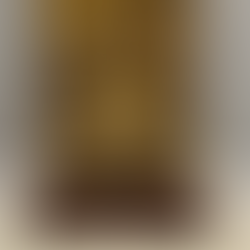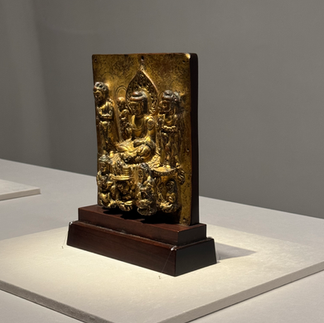唐代筆記 vol.40 根津美術館:唐代鎚鍱銅鎏金五尊佛像,對比兩尊銅鎏金北魏飛天 - Nezu Museum, Tang Dynasty Hammered Gilt Bronze Five Buddha Pentad
- SACA

- Jun 12
- 9 min read

鎚鍱(chuí yè)像是一種具有高度技術性和藝術價值的金屬工藝品,通過將薄銅板壓於模具上並以槌擊成型,創造出具有浮雕效果的佛像或其他工藝品。
此技法源自中國,並在隋唐時期達到高度發展,對日本的飛鳥及奈良時代的佛像製作產生了深遠影響。參考兩尊北魏時期的銅鎏金鎚鍱像,一尊來自納爾遜博物館,由laurence sickman在1934年在北京購藏;另一尊來自佐藤玄玄、坂本五郎的收藏,2016年於蘇富比售出:

鎚鍱像不僅具有精緻的群像構圖和細膩的細節處理,還展現了唐代金工技術的卓越成就。從技術層面來看,鎚鍱技法強調了槌擊與型模的巧妙應用,並且在精加工階段多數不再依賴型模,轉而使用槌起技法,使每件作品具有高度的獨特性與藝術性。
這一技法在日本的文獻中雖未使用“鎚鍱”一詞,但從與中國押出佛技法的比較來看,鎚鍱像無疑是一種更為複雜且進階的金屬加工技術,表現了唐代金工在工藝與藝術上的極致追求。因此,鎚鍱像在今天依然被視為貴重的文化遺產,代表了古代金屬工藝的巔峰。

Hammered relief sculptures, known as tsuichō-zō (鎚鍱像), represent a highly skilled and valuable form of metalwork, where thin copper plates are hammered over molds to create relief images of Buddha and other figures. This technique, originating in China, reached its peak during the Sui and Tang dynasties and had a profound influence on Japanese Buddhist sculpture during the Asuka and Nara periods. The hammered relief figures are recognized for their intricate group compositions and detailed craftsmanship, which showcase the exceptional metalworking skills of the Tang Dynasty.
Technically, the tsuichō technique emphasizes the use of hammers and molds, with artisans first shaping the basic form before refining the details with chisels. Notably, the final stage of crafting these figures often involves the use of tsuki-ki(hammering technique) instead of molds, contributing to the uniqueness of each piece.
While the term tsuichō is not explicitly used in Japanese historical texts—where terms like osidashi (押出し) or uchi-dashi (打ち出し) are more common—the technique can be seen as a more advanced and complex evolution of the osidashi-butsu technique, which also involves metal sheets but with simpler molding processes.
In conclusion, the tsuichō-zō represents a highly sophisticated and distinct metalworking method, embodying the zenith of Tang Dynasty craftsmanship and continuing to be valued as an important cultural and artistic heritage.
本品係以厚度約一毫米之銅板,透過錘鍱技法打製而成之浮雕狀佛像,所表現者為如來、菩薩等諸尊。其構圖群像繁密、氣韻生動,為金工藝術中之傑出名品,尤以其群像配置與打製技術之高超聞名。
製作時,工匠將銅板覆於原型之上,以槌擊打出大致形體,脫模後再行細部敲打補形,並以鏨(たがね,雕刻用之刻刀)進行精細雕琢,完成面部表情、衣紋褶皺等細節。此種分層次、復合式的加工流程,體現出唐代金工在立體塑形與細節表現上的卓越工藝水準。
該像最深處之起伏達五公分之多,呈現出極具量感與厚重感的造形語彙,可謂完整保存並展現唐代金工藝術高度發展之貴重遺例。

This piece is a remarkable example of hammered copper-gilt Buddha statues, created using copper plates approximately 1 millimeter thick. The figures, representing the Buddha and Bodhisattvas, were crafted using the hammered relief technique (鎚鍱), and are renowned for their intricate group composition and the exceptional metalworking skills displayed in their execution.
During the creation process, artisans placed a copper plate over the model, using a hammer to strike and shape the basic form. After removing the mold, they further refined the details by hammering and finishing with a chisel (鏨, a type of engraving tool), delicately sculpting the facial expressions and the folds of the robes. This multi-layered, composite approach highlights the extraordinary craftsmanship of Tang Dynasty metalwork, particularly in its use of three-dimensional shaping and detailed representation.
The depth of the figures reaches a maximum of 5 centimeters, showcasing a strong sense of volume and weight. This piece not only exemplifies the height of Tang Dynasty metalworking but also serves as a precious relic that fully preserves and conveys the advanced techniques of the period.
厚さ1ミリ程度の銅板から、如来や菩薩などを打ち出した浮脂状の仏像で、卓越した群像表現と金工技術で知られる名品。原型の上に銅板をのせて鎚で打ち出し、型を外した上で更に打ち込みを行い、鏨で細部を仕上げたとみられる。像の奥行きが最大5cmにもなる、量感に溢れたこの作品は、唐時代の極めて高度な金工技術を伝える貴重な作品といえる。

關於鎚鍱(chuí yè)
鍱
yè ㄧㄝˋ
薄铁片:“或剪铁~”。
用薄铁片包裹:“门关再重,~之以铁,必坚。”
鎚鍱(ついちょう),是一種以錘擊手法將金屬薄板壓於模具之上,使其浮起成形的金屬加工技術。此技術廣泛應用於佛像製作(如「押出佛」或「鎚鍱佛」)與各類金屬工藝品之中,具有重要的歷史與工藝價值。
押出佛(おしだしぶつ):係指將金屬薄板加壓於陽模或陰模(即雄型或雌型)之上,藉由錘擊使其浮起,成為立體造形的佛像。此技術源自中國,隋唐時期即有實例流傳,傳入日本後,奈良時代亦出現多件代表作。
鎚鍱佛(ついちょうぶつ):與押出佛意義相同,專指採用鎚鍱技法,即以錘擊方式將金屬薄板浮雕成形所製作之佛像。
金屬工藝中的應用:鎚鍱技法亦廣泛運用於金、銀、銅、錫等金屬材質之加工,例如製作裝飾品、容器、日用品等工藝品,展現高超的成形與裝飾技巧。
工具與模具:鎚鍱製作需依賴「槌」(即錘子)與「型」(包括陽模與陰模)。工匠將金屬薄板覆於模具上,以槌敲擊,使之逐步貼合模具紋樣,形成浮凸圖像或造形。
浮雕效果:經鎚鍱技法製作的佛像或金屬工藝品,表面通常呈現浮雕式立體感,具有鮮明的光影層次與藝術效果。
歷史與發展:鎚鍱技法可追溯至日本古墳時代,至奈良時代已有確切的「鎚鍱像」傳世。其後,技法漸趨成熟,並應用至更多世俗與宗教用途的金屬器物之上。

相關技術術語:
鎚起銅器(ついきどうき):
「鎚起」為將金屬薄板以錘擊方式塑造成中空立體形狀之技術,與鎚鍱同屬「錘成形」之範疇,常見於銅壺、茶器等高級工藝品。
鎚金(ついきん):
泛指一切以槌擊方式對金屬進行加工之技術,包括鎚鍱、鎚起等,為日本傳統金工技術之總稱。

中國歷史中的「錘鍱」
中國古代金銀首飾發展史的早期階段中,製作工藝、也包括若干樣式的來源。中土金銀首飾的使用和製作,廣泛流傳是在兩漢。域外早已成熟的工藝,諸如鏃鏤、打作、累絲、粟粒焊接、寶石鑲嵌,此際自不妨「拿來」,而在發展進程中融入既有的文化傳統和技術傳統,逐步形成自己的特色。首飾製作,與金銀器皿的情況相同,即最常用也是最基本的工藝是打造,便是今人之所謂「錘鍱」。不過「錘鍱」古時並不是打造的意思。
鍱,《說文.金部》雲「鏶也」。朱駿聲《說文通訓定聲》:「凡金、銀、銅、鐵、錫椎薄成葉者,謂之鏶」。玄應《一切經音義》卷三:「鍱,薄金也」。徐鍇《說文解字系傳》雲:鍱,「今言鐵葉也」。「今」,即南唐。明張自烈《正字通》:「銅鐵椎練成片者日鍱」。可知鍱最出的意思是金屬片。由此引申為製成各種花樣的裝飾片,其質地為金屬,或鐵,或金,或銀,或塗金亦即鎏金。江淹《麗色賦》狀寫佳人之飾雲「鍱金花於珠履」,所謂「鍱金花」,便是貼飾在珠履上的清薄細巧的金花片。金銀花片若再裝飾圖案,則又稱作「鏤鍱」和「鎚鍱」。「鎚鍱」之鍱,系鍱之別寫,慧琳《一切經音義》卷。九十釋「鎚鍱」曰:「即隱起金鍱佛像也,或熟銅隱鏤成像,以金鍍飾,或真金鍱、銀鍱隱起而成,裝作檀籠,是此功德也」。

Hammered Metal Figures in Chinese History
In the early stages of the development of ancient Chinese gold and silver jewelry, various manufacturing techniques and styles were introduced, some of which originated from outside China. The use and crafting of gold and silver in China were widely prevalent during the Han Dynasty. Pre-existing techniques such as engraving, casting, filigree, granulation, and gemstone inlay, which were already well-established in foreign cultures, were adopted. Over time, these techniques were integrated with traditional Chinese cultural and technical practices, gradually forming a distinctive style.

The crafting of jewelry, much like gold and silver vessels, often relied on the basic yet most common technique of "hammering"—what we refer to as "錘鍱" (chuí yì). However, in ancient times, the term "錘鍱" did not simply mean the act of crafting or molding.
According to the Shuōwén Jiězì (説文解字), a classic Chinese dictionary, "鍱" refers to thin metal sheets, with the definition describing it as "a thin layer of metal." For instance, Zhu Junsheng's Shuōwén Tōngxùn Dìngshēng describes it as "metal sheets made from copper, iron, and tin," and Xu Kai's Shuōwén Jiězì Xìzhuàn notes that "鍱" specifically refers to iron sheets. The term "鍱" is also used in reference to thin, metallic decorative pieces—whether they are made from iron, gold, or silver, or gilded with gold. The Lìsèfù by Jiang Yan depicts "鍱金花," which refers to thin, delicate flower-shaped pieces made from metal and affixed to footwear, an example of such adornment.
When these metal flower pieces were further decorated with patterns, they were often called "鏤鍱" (lòu yì) or "鎚鍱" (chuí yì). The term "鎚鍱," often associated with "錘鍱," specifically refers to the technique of hammering metal to create relief images, such as the hammered metal Buddha figures. As explained in Yīqiè Jīng Yīnyì by Huìlín, "鎚鍱" refers to "hammered metal representations, such as Buddha figures or other images made of gold-plated copper or pure gold, sometimes also used to adorn decorative elements like covers or vessels."
Thus, "鎚鍱" originally denoted the technique of hammering and shaping metal sheets into ornamental forms, a skill that played a significant role in the development of ancient Chinese jewelry and other decorative items.

日本學者觀點
鎚鍱像(ついちょうぞう)「鍱」指的是金屬薄板。鎚鍱像是將銅板等金屬薄片置於鑄造的型上,然後用槌子敲打或彎曲,將其打造成類似浮雕風格的像。這些像有時會將單獨製作的前後兩部分結合起來,形成類似圓雕的形態。此技法具有在短時間內製作多個相同像的特點。
在飛鳥時代與奈良時代(7至8世紀)時期,日本受到中國六朝末期、隋朝、唐朝的影響,出現了「押出佛」的流行。而現今,這一技法在中國的用語也常解釋為同義。然而,從中國的遺例來看,雖然表現手法相同的像有多個,但使用型模的事實是確定的。然而,在細部的處理上存在微妙的差異,並且從背面觀察時,打出的部分的深度會擴展,呈現出像口形收縮的效果。如果整個過程都使用型模,這樣的形狀會使型模無法拔出。因此,可以推測,鎚鍱像在最後的精加工階段幾乎不再使用型模,而是採用了槌起技法。
在奈良時代的日本文獻中,雖然有提及「押出」或「打出」等詞語,但從未出現過「鎚鍱」這一術語。當時的技術術語大多遵循中國的用法,而「鎚鍱」的使用在當時是一個極為異常的現象。
根據以上各點分析,鎚鍱像與日本的押出佛技法有著兄弟關係,但可以推斷其技術手法是更為高度且複雜的別種技法。
— 佐藤昭夫

Japanese Scholar's Perspective
The term "鎚鍱像" (tsuichōzō) refers to metal relief sculptures made from thin metal sheets. The technique involves placing thin copper or other metal sheets onto a cast mold, then using a hammer to strike or bend the metal, shaping it into a relief-like figure. Sometimes, two separate parts are made and combined to form a round sculpture. This method allows for the rapid production of multiple identical figures.
During the Asuka and Nara periods (7th to 8th centuries), Japan was influenced by the late Six Dynasties, Sui, and Tang China, leading to the popularity of "press-molded Buddhas" (押出仏). Today, this technique is often considered synonymous with the "鎚鍱" method in Chinese terminology. However, based on Chinese examples, while the figures may appear similar, it is confirmed that molds were used in their creation. Subtle differences in the finishing process can be observed, particularly when viewed from the back, where the hammered areas deepen, creating a contracted mouth-like effect. If molds were used throughout the entire process, such a form would make it difficult to extract the mold. Therefore, it can be inferred that the final stages of the "鎚鍱像" technique almost certainly involved the use of hammering rather than relying on molds.
Although the terms "押出" or "打出" (press-molded or struck-out) are mentioned in Japanese literature from the Nara period, the term "鎚鍱" never appears. The technical vocabulary of the time largely followed Chinese terminology, and the use of "鎚鍱" would have been a highly unusual occurrence at that time.
Based on these points, it can be concluded that "鎚鍱像" and Japan's press-molded Buddha technique share a sibling relationship. However, the "鎚鍱" technique appears to be a more advanced and complex variation.
— Akio Sato


























Comments